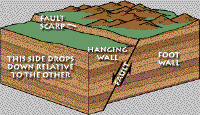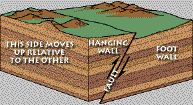Faults
Faults are fractures in the crust of a
planetary body along which some movement has occurred.
Displacement along the fault may be caused by extremely
slow, continuous movement, or by rapid fracturing as built
up stress is suddenly released. Movement along a fault can
be vertical, horizontal, or lateral.
Two types of force or stress that can
be applied to rock are tensional force, which results in the
pulling apart of crustal rocks, and compressional force,
which squeezes rocks together. Another kind of force is
shearing, which causes the rocks to slide past each
other.
 Faults
are classified by the way in which the rocks on either side
of the fault move in relation to one another. In a normal
fault, the hanging wall drops down relative to the footwall.
This downward movement results in a steep cliff or fault
scarp. (How can you tell the difference between the hanging
wall and the footwall? The footwall is the one that is
roughly shaped like a foot--wider at the base and sloping
inward as it moves up.) These faults are called "normal"
faults because downward motion is the normal response to
gravity. Faults
are classified by the way in which the rocks on either side
of the fault move in relation to one another. In a normal
fault, the hanging wall drops down relative to the footwall.
This downward movement results in a steep cliff or fault
scarp. (How can you tell the difference between the hanging
wall and the footwall? The footwall is the one that is
roughly shaped like a foot--wider at the base and sloping
inward as it moves up.) These faults are called "normal"
faults because downward motion is the normal response to
gravity.
 Movement
along a reverse fault is opposite that of a normal fault.
The hanging wall moves upward in relation to the footwall.
This is the reverse of the normal response to gravity, and
hence the name, reverse fault. If a reverse fault is low
angle, 45 degrees or less, it is called a thrust fault.
Reverse faults occur where opposing horizontal forces
compress the crust enough to cause it to fracture, and force
one crustal block to rise over the other. Movement
along a reverse fault is opposite that of a normal fault.
The hanging wall moves upward in relation to the footwall.
This is the reverse of the normal response to gravity, and
hence the name, reverse fault. If a reverse fault is low
angle, 45 degrees or less, it is called a thrust fault.
Reverse faults occur where opposing horizontal forces
compress the crust enough to cause it to fracture, and force
one crustal block to rise over the other.
Illustration Credit:
USGS
|
 Photoglossary
Photoglossary Photoglossary
Photoglossary